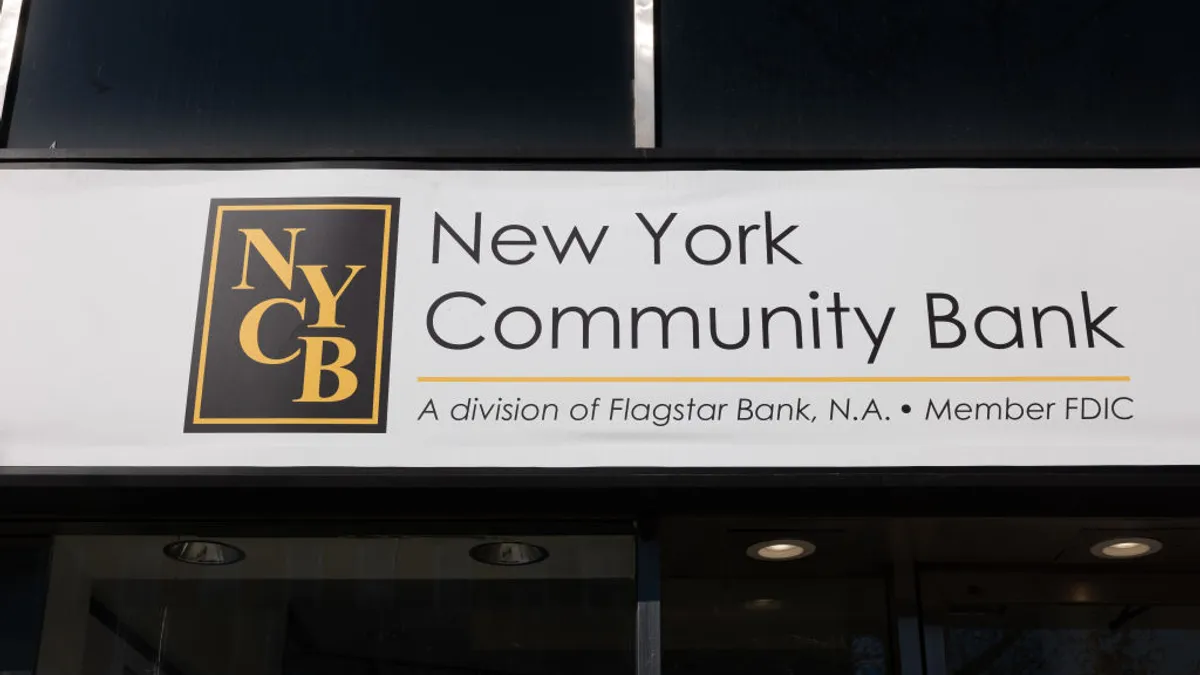Dive Brief:
- New York Community Bank’s Flagstar is reducing its headcount by 1,900 roles, the Hicksville, New York-based lender announced Thursday.
- About 700 employees, or 8% of the bank’s workforce, have been cut, in line with a strategy NYCB had already outlined, the lender said. The other 1,200 affected employees are leaving the bank’s purview when NYCB finalizes the sale of its mortgage servicing and third-party origination business to mortgage firm Mr. Cooper. NYCB expects that transaction to close this quarter.
- “We approached this decision with empathy and compassion for everyone affected,” NYCB CEO Joseph Otting said in a statement Thursday. “We want to express our appreciation for our employees' contributions.”
Dive Insight:
Most of the latter 1,200 employees “will be offered the opportunity to transfer” to Mr. Cooper, “facilitating a smooth transition,” NYCB said Thursday.
The former 700 cuts “will not impact [NYCB’s] service or progress” because “in many cases, roles were similar or duplicative,” the bank said, noting that it is “further integrating” Flagstar, Signature and NYCB operations.
“By right sizing our team after bringing three banks together, we are optimizing our operations to move forward with strength and clarity,” Otting said. "While these strategic actions involve difficult decisions, including impacts on jobs, we believe they are essential for strengthening our financial foundation and building a more agile, competitive company.”
The Office of the Comptroller of the Currency and the Federal Reserve approved NYCB’s acquisition of Flagstar in late 2022 and, less than six months later, the combining lender assumed assets from the collapsed Signature Bank. That transaction pushed NYCB past a $100 billion-asset threshold requiring stricter regulatory oversight.
Additionally, the bank’s exposure to commercial real estate gave it an unexpected $252 million loss in January, forcing NYCB to cut its quarterly dividend by 70%. The surprise announcement sent NYCB’s share price into a spiral that deepened when the bank took a $2.4 billion impairment charge and replaced its CEO.
A turnaround began, though, when the bank received a $1.05 billion capital infusion in March from investors led by former Treasury Secretary Steven Mnuchin. The investors installed Otting, a former OCC chief, as CEO.
In his statement Thursday, Otting cited “significant progress this year,” including “strengthening our management and Board, redefining our operational plan for improved efficiency and enhancing our credit oversight and risk framework.”
Another benchmark for NYCB’s progress comes Oct. 25, when the bank is set to announce its third-quarter earnings. On the same day, the bank will adopt Flagstar Financial as its new brand name. It will also change its ticker symbol to FLG as of the open of business Oct. 28.
Not all observers are as enthusiastic about the bank’s journey. Sens. Elizabeth Warren, D-MA, and Richard Blumenthal, D-CT, castigated the OCC in April, asserting the agency was “asleep at the wheel” when it approved the NYCB-Flagstar merger. The deal, first proposed in April 2021, failed to gain traction – particularly with the Federal Deposit Insurance Corp. So a year later, the banks proposed transitioning Flagstar’s federally chartered state savings bank subsidiary into a national banking association, then merging NYCB’s state-chartered savings bank subsidiary into the national bank – a move that would bypass FDIC approval.
The OCC approved the tie-up in October 2022, calling the charter change a “business decision” and adding “preference of charters does not constitute a statutorily relevant consideration under the [Bank Merger Act].”
In Thursday’s announcement, NYCB alluded that it may not be done right-sizing. The bank “will continue to pursue opportunities to optimize [its] operations and enhance efficiency, paving the way for a more resilient and successful future,” Otting said.










